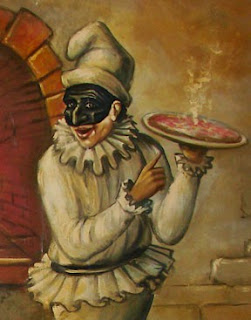A hookah (hukkā or huqqah) also known as a waterpipe, narghile, or Qalyān (Persian: قلیان), is a single or multi-stemmed instrument forsmoking flavored tobacco called Mu‘assel (also known as Shisha شیشه) in which the smoke is passed through a water basin (often glass based) before inhalation. The origin of the hookah is India, Pakistan and Persia, or at a transition point between the two. The word hookah is a derivative of "huqqa", which is what the Indians used to call it. According to author Cyril Elgood (pp. 41, 110), who does not mention his source, it was Abul-Fath Gilani (d. 1588), a Persian physician at the Indian court of the Mughal emperor Akbar, who “first passed the smoke of tobacco through a small bowl of water to purify and cool the smoke and thus invented the hubble-bubble or hookah.” Nevertheless, a quatrain of Ahli Shirazi (d. 1535) refers to the use of the ḡalyān in Safavid Iran. (Falsafī, II, p. 277; Semsār, 1963, p. 15). Smoking the hookah has gained popularity outside of its native region, in India, Pakistan and the Middle East, and is gaining popularity in North America, South America, Europe, Australia and South Africa.
Names and etymology
Nargile (but sometimes pronounced Argileh or Argilee) is the name most commonly used in Turkey, Italy, Greece, Cyprus, Azerbaijan, Uzbekistan, Iraq, Jordan, Lebanon, Yemen, and Israel. Nargile derives from the Persianegypt word nārghile, meaning coconut, which in turn is from the Sanskrit wordnārikela (नारिकेला), suggesting that early hookahs were hewn from coconut shells.
In Albania, Bosnia and Herzegovina the hookah is called "lula" or "lulava" in Romani, meaning "pipe"; the word "shishe" refers to the actual bottle piece.
In Croatia, Serbia, Bosnia and Herzegovina, the Republic of Macedonia and Bulgaria, na[r]gile (на[р]гиле; from Turkish nargile) is used to refer to the pipe. Šiša (шиша) usually refers to the tobacco that is smoked in it. The pipes there often have one or two mouth pieces. The flavored tobacco, created by marinating cuts of tobacco in a multitude of flavored molasses, is placed above the water and covered by pierced foil with hot coals placed on top, and the smoke is drawn through cold water to cool and filter it.
"Narguile", is the common word in Spain used to refer to the pipe, although "cachimba" is also used, along with "shisha" by Moroccan immigrants in Spain.
Shisha (شيشة), from the Persian word shīshe (شیشه), meaning glass, is the common term for the hookah in Egypt, Sudan and the Arab countries of thePersian Gulf (including Kuwait, Bahrain, Qatar, Oman, UAE, and Saudi Arabia), and in Algeria, Morocco, Tunisia, Somalia and Yemen.
In Iran/Persia, hookah is called "ḡalyān" (Farsi:قلیان). Persian qalyan is included in the earliest European compendium on tobacco, the tobacolgia written by Johan Neander and published in Dutch in 1622. It seems that over time water pipes acquired an Iranian connotation as in eighteenth-century Egypt the most fashionable pipes were called Karim Khan after the Iranian ruler of the day. This is also the name used in Ukraine, Russia and Belarus.
In Uzbekistan and Afghanistan, a hookah is called chillim.
In India and Pakistan the name most similar to the English hookah is used: huqqa (हुक़्क़ा /حقّہ)
In Maldives, hookah is called "Gudugudaa".
The hookah pipe is also known as the "Marra pipe" in the UK, especially in the North East, where it is used for recreational purposes.
The widespread use of the Indian word "hookah" in the English language is a result of the British Raj, the British dominion of India (1858–1947), when large numbers of expatriate Britons first sampled the water pipe. William Hickey, shortly after arriving in Kolkata, India, in 1775, wrote in his Memoirs:
Initial traces of hookah smoking have been found in the North Western provinces of India in the states of Rajasthan and Gujarat. In North India, it is a great tradition followed by Gurjars, Jats, Bishnois, Rajputs, etc. According to Cyril Elgood (PP.41, 110) it was in India where the physician Hakim Abu’l-Fath Gilani (d. 1588), at the court of the Mughal emperor Akbar I (1542 - 1605 AD) invented the idea.Following the European introduction of tobacco to Persia and India, Hakim Abu’l-Fath Gilani, who came from Gilan, a province in the north of Iran, migrated to India. He later became a physician in the Mughal court and raised health concerns after smoking tobacco became popular among Indian noblemen. He subsequently envisaged a system which allowed smoke to be passed through water in order to be 'purified'. Gilani introduced the ḡalyān after Asad Beg, the ambassador of Bijapur, encouraged Akbar I to take up smoking.Following popularity among noblemen, this new device for smoking soon became a status symbol for the Indian aristocracy and gentry. However, a quatrain of Ahlī Shirazi (d. 1535), a Persian poet, refers to the use of the ḡalyān (Falsafī, II, p. 277; Semsār, 1963, p. 15), thus dating its use at least as early as the time of the Shah Ṭahmāsp I. It seems, therefore, that Abu’l-Fath Gilani should be credited with the introduction of the ḡalyān, already in use in Persia, into India.
In Albania, Bosnia and Herzegovina the hookah is called "lula" or "lulava" in Romani, meaning "pipe"; the word "shishe" refers to the actual bottle piece.
In Croatia, Serbia, Bosnia and Herzegovina, the Republic of Macedonia and Bulgaria, na[r]gile (на[р]гиле; from Turkish nargile) is used to refer to the pipe. Šiša (шиша) usually refers to the tobacco that is smoked in it. The pipes there often have one or two mouth pieces. The flavored tobacco, created by marinating cuts of tobacco in a multitude of flavored molasses, is placed above the water and covered by pierced foil with hot coals placed on top, and the smoke is drawn through cold water to cool and filter it.
"Narguile", is the common word in Spain used to refer to the pipe, although "cachimba" is also used, along with "shisha" by Moroccan immigrants in Spain.
Shisha (شيشة), from the Persian word shīshe (شیشه), meaning glass, is the common term for the hookah in Egypt, Sudan and the Arab countries of thePersian Gulf (including Kuwait, Bahrain, Qatar, Oman, UAE, and Saudi Arabia), and in Algeria, Morocco, Tunisia, Somalia and Yemen.
In Iran/Persia, hookah is called "ḡalyān" (Farsi:قلیان). Persian qalyan is included in the earliest European compendium on tobacco, the tobacolgia written by Johan Neander and published in Dutch in 1622. It seems that over time water pipes acquired an Iranian connotation as in eighteenth-century Egypt the most fashionable pipes were called Karim Khan after the Iranian ruler of the day. This is also the name used in Ukraine, Russia and Belarus.
In Uzbekistan and Afghanistan, a hookah is called chillim.
In India and Pakistan the name most similar to the English hookah is used: huqqa (हुक़्क़ा /حقّہ)
In Maldives, hookah is called "Gudugudaa".
The hookah pipe is also known as the "Marra pipe" in the UK, especially in the North East, where it is used for recreational purposes.
The widespread use of the Indian word "hookah" in the English language is a result of the British Raj, the British dominion of India (1858–1947), when large numbers of expatriate Britons first sampled the water pipe. William Hickey, shortly after arriving in Kolkata, India, in 1775, wrote in his Memoirs:
The most highly-dressed and splendid hookah was prepared for me. I tried it, but did not like it. As after several trials I still found it disagreeable, I with much gravity requested to know whether it was indispensably necessary that I should become a smoker, which was answered with equal gravity, "Undoubtedly it is, for you might as well be out of the world as out of the fashion. Here everybody uses a hookah, and it is impossible to get on without ...[I] have frequently heard men declare they would much rather be deprived of their dinner than their hookah.



















